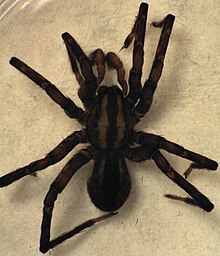Gradungulidae
| Large-clawed spiders | |
|---|---|
 | |
| Gradungula sorenseni, male | |
| Scientific classification | |
| Domain: | Eukaryota |
| Kingdom: | Animalia |
| Phylum: | Arthropoda |
| Subphylum: | Chelicerata |
| Class: | Arachnida |
| Order: | Araneae |
| Infraorder: | Araneomorphae |
| Family: | Gradungulidae Forster, 1955 |
| Diversity | |
| 7 genera, 16 species | |
 | |
Gradungulidae, also known as large-clawed spiders, is a spider family endemic to Australia and New Zealand. They are medium to large-sized haplogyne spiders with three claws and two pairs of book-lungs similar to Mygalomorphae. Some species build extensive webs with an upper retreat tangle and connecting threads to scaffolding. This supports the ladder-like catching platform that is glued to the ground. Progradungula, a large spider with long legs like Hickmania,[1] and Macrogradungula are the only cribellate genera of the family.
Species
Gradungula Forster, 1955
- Gradungula sorenseni Forster, 1955 — New Zealand
Kaiya Gray, 1987
- Kaiya bemboka Gray, 1987 — New South Wales
- Kaiya brindabella (Moran, 1985) — Australian Capital Territory
- Kaiya parnabyi Gray, 1987 — Victoria
- Kaiya terama Gray, 1987 (type species) — New South Wales
Macrogradungula Gray, 1987
- Macrogradungula moonya Gray, 1987 — Queensland
Pianoa Forster, 1987
- Pianoa isolata Forster, 1987 — New Zealand
Progradungula Forster & Gray, 1979
- Progradungula carraiensis Forster & Gray, 1979 (type species) — New South Wales
- Progradungula otwayensis Milledge, 1997 — Victoria
Spelungula Forster, 1987
- Spelungula cavernicola Forster, 1987 — New Zealand
Tarlina Gray, 1987
- Tarlina daviesae Gray, 1987 — Queensland
- Tarlina milledgei Gray, 1987 — New South Wales
- Tarlina noorundi Gray, 1987 (type species) — New South Wales
- Tarlina simipes Gray, 1987 — Queensland
- Tarlina smithersi Gray, 1987 — New South Wales
- Tarlina woodwardi (Forster, 1955) — Queensland
References
- ^ Forster, R. R.; Gray, M. R. (1979). "Progradungula, a new cribellate genus of the spider family Gradungulidae (Araneae)". Australian Journal of Zoology. 27 (6): 1051–1071. doi:10.1071/ZO9791051.
- Forster, R. R., Platnick, N. I. and Gray, M. R. (1987): A review of the spider superfamilies Hypochiloidea and Austrochiloidea (Araneae, Araneomorphae). Bulletin of the AMNH 185(1): 1-116 Abstract - PDF (50Mb)
External links

- Carrai cave spider Progradungula carraiensis
- v
- t
- e
- Kingdom: Animalia
- Phylum: Arthropoda
- Subphylum: Chelicerata
- Class: Arachnida
Suborder Mesothelae | |
|---|---|
|
Suborder Opisthothelae | |||||||||||||||
|---|---|---|---|---|---|---|---|---|---|---|---|---|---|---|---|
| |||||||||||||||
- Spider taxonomy
- Bold are families with more than 1000 species
 | This article related to araneomorph spiders is a stub. You can help Wikipedia by expanding it. |
- v
- t
- e









